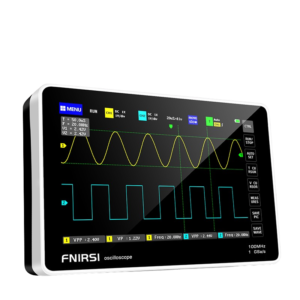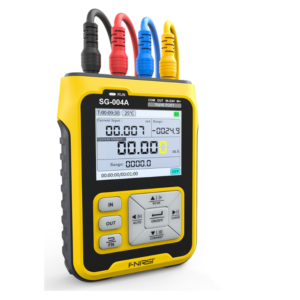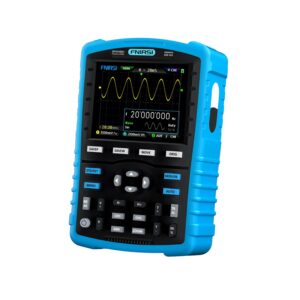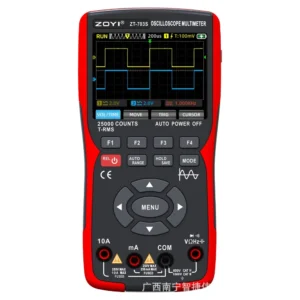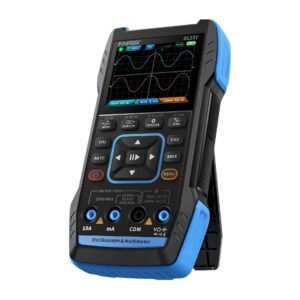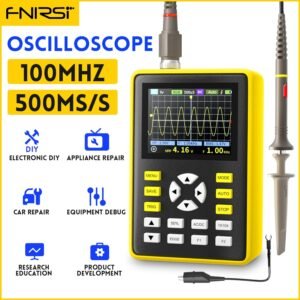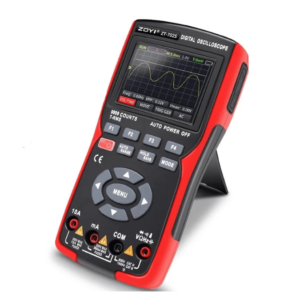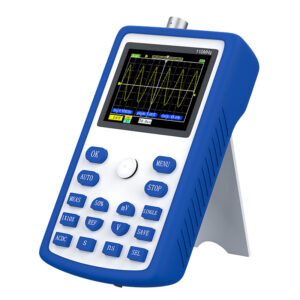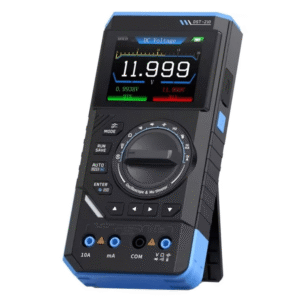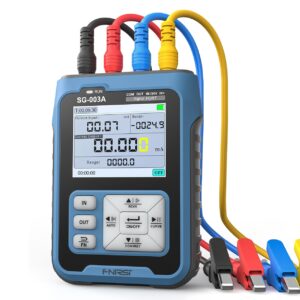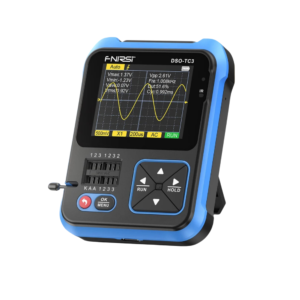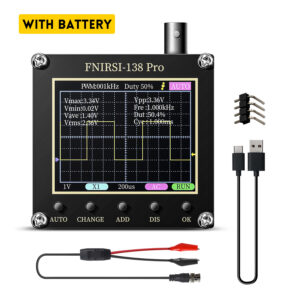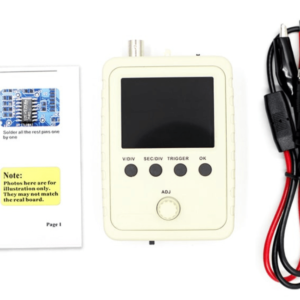Handheld Oscilloscope
Explore our range of portable handheld oscilloscopes, designed for precision and convenience. Ideal for troubleshooting and diagnostics across various electronic systems, our models combine portability with high accuracy. Backed by a 1-year guarantee and hassle free return. Shipped directly from the UK by Kunkune.
Showing all 14 resultsSorted by price: high to low
- Price range: £16.90 through £24.90Select options This product has multiple variants. The options may be chosen on the product page
Showing all 14 resultsSorted by price: high to low
What Is a Handheld Oscilloscope?
A handheld oscilloscope is a compact and portable diagnostic instrument designed for waveform analysis in various electronic applications, allowing technicians and engineers to conduct real-time observations and measurements of electrical signals with high accuracy. These advanced diagnostic tools often complement the use of digital multimeters, offering comprehensive solutions for electrical testing and analysis. Handheld oscilloscopes are especially valuable in hazardous industrial environments where portability and efficiency are crucial. Furthermore, the rugged design ensures durability in harsh conditions.
Models like the FNIRSI oscilloscopes, including FNIRSI SG-004A and , FNIRSI SG-003A offer features that enhance the troubleshooting process, making them critical for professionals in electronic industries such as RF communications and EMI testing.
Why Use a Handheld Digital Oscilloscope?
Using a handheld digital oscilloscope provides numerous advantages for professionals in fields such as automotive, telecommunications, and RF communications, where quick and efficient troubleshooting is essential. High performance oscilloscopes in this category are known for their reliability and advanced features.
These portable oscilloscopes not only offer high performance but also feature advanced functionalities such as Connect-and-View mode, which simplifies oscilloscope setup and enhances usability, making them integral tools for signal generation and analysis tasks.
Portability
Portability is a defining feature of handheld oscilloscopes, allowing engineers to conduct measurements on-site in various electronic industries such as automotive and telecommunications. This flexibility makes them invaluable for tasks involving real-time monitoring and waveform analysis in hazardous industrial settings. Models like the FNIRSI SG-003A embody this convenience, ensuring that professionals can easily transport their diagnostic tools without sacrificing performance.
The significance of portability cannot be overstated, especially when engineers are tasked with troubleshooting issues in remote locations or crowded environments like a manufacturing floor. For instance, when working on vehicle electrical systems, having a lightweight and compact device means that technicians can quickly diagnose problems without the need to move large equipment.
In the telecommunications sector, timely identification of signal quality can make a crucial difference in service levels. Handheld oscilloscope like the FNIRSI-DPOX180H Oscilloscope not only enable effective fieldwork but also ensure that professionals can capture important data effortlessly on the move.
Convenience
The convenience offered by handheld oscilloscope, particularly with features like efficient automatic configuration and Connect-and-View mode, streamlines the troubleshooting process, allowing users to focus on analysis rather than setup. This user-friendly design is evident in models like the FNIRSI DPOX180H, which simplifies waveform analysis and enhances overall productivity, making it a preferred choice among technicians in the field, especially in power supply applications.
Users appreciate how these oscilloscopes come equipped with a variety of intuitive features that not only expedite the initial setup but also facilitate ongoing analysis. Key characteristics such as:
- Portable design for easy handling in various environments,
- High-resolution displays that ensure clarity and accuracy in readings,
- Multichannel capabilities allowing for comprehensive signal observations,
- and built-in analysis tools that provide real-time insights.
Cost-Effectiveness
Cost-effectiveness is a significant consideration when choosing a digital oscilloscope, as it allows technicians to acquire high-performance oscilloscopes without exceeding budget constraints. Kunkune’s FNIRSI range provides a variety of models that balance affordability with advanced features, ensuring that professionals in electronic industries can access reliable diagnostic tools for their needs.
When comparing the pricing of handheld oscilloscopes to traditional models, it becomes evident that the investment can often yield superior value. For instance, the portability of the FNIRSI series not only enhances usability in the field but also saves time and money on transport logistics, crucial for technicians on the move. Additionally, their digital oscilloscope functionality provides versatility for various applications.
- Many models offer features such as:
- Large touch screens for easy navigation
- Multiple input channels for simultaneous measurements
These features justify the pricing difference, as they elevate the diagnostic process, making handheld models a sensible choice. Ultimately, by integrating performance and convenience.
Types of Portable Handheld Oscilloscopes
There are several types available on the market, each tailored for specific applications and user needs, including digital storage oscilloscopes (DSO), digital phosphor oscilloscopes (DPO), and digital sampling oscilloscopes.
The FNIRSI range, known for its advanced diagnostic tools, offers a diverse selection of models that cater to different requirements in waveform analysis and troubleshooting processes across various electronic industries.
Digital Storage Oscilloscope (DSO)
A digital storage oscilloscope (DSO) is designed to capture and store waveform data, allowing for detailed analysis and troubleshooting in electronic applications. Models like the FNIRSI DPOX180H excel in this category, providing high sample rates and advanced features that support waveform analysis for various industries, including automotive and telecommunications. The inclusion of FFT analysis further enhances their diagnostic capabilities.
These oscilloscopes are particularly valued for their memory depth, which enables users to capture long-duration signals at high resolution. With increased memory, engineers can analyse intricate waveforms without compromising data integrity or clarity. The impressive sampling rate offered by devices like the FNIRSI allows for precise measurements, crucial in applications ranging from circuit design to signal integrity analysis and waveform generator testing.
- High Sampling Rate: Ensures accurate representation of fast-changing signals.
- Advanced Triggering Options: Facilitates detection of specific events in complex waveforms.
- Versatile Measurement Capabilities: Useful in various fields including healthcare, automotive diagnostics, and telecommunications.
As technology continues to evolve, the relevance of these oscilloscopes in meeting industry demands only increases.
Digital Phosphor Oscilloscope (DPO)
Digital phosphor oscilloscopes (DPO) offer enhanced visualisation capabilities by using phosphor technology to display waveforms, providing insights into signal variations over time.
This advanced technology allows users to easily spot transient events and anomalies that might be missed with traditional oscilloscopes, functioning as a vital tool in various applications. DPOs play a significant role in power supply analysis, where precise waveform observation is crucial for ensuring stability and efficiency.
They facilitate the examination of:
- power integrity
- load regulation
- switching characteristics
—features that are pivotal for engineers dealing with complex electronic systems.
The ability to capture and analyse fast-changing signals greatly benefits the design and troubleshooting phases, ensuring that the devices perform optimally under different operating conditions.
Digital Sampling Oscilloscope (DSO)
Digital sampling oscilloscopes (DSO) specialise in capturing high-frequency signals with impressive sampling rates, making them essential tools in electronic industries where precision is paramount. These oscilloscopes are particularly suited for applications like RF communications and EMI testing, providing users with reliable data for detailed analysis.
High sampling rates, often exceeding several giga-samples per second, enable these tools to visualise signal integrity with remarkable clarity. This capability is invaluable in various sectors such as telecommunications, where ensuring optimal signal performance is critical, and in RF communications for precise signal assessment.
- In RF communications, understanding modulation schemes and bandwidth requirements is facilitated by the detailed insights provided by DSOs and FNIRSI oscilloscopes.
- EMI testing benefits from their ability to capture transient phenomena, with advanced features like FFT analysis helping professionals diagnose complex interference issues.
- In addition, their compact form and user-friendly interfaces make them adaptable for field testing, catering to engineers on the move.
As electronic systems continue to evolve, the role of digital sampling oscilloscopes and FNIRSI oscilloscopes in ensuring reliability and performance will only expand.
Features to Consider When Buying a Handheld Oscilloscope
When purchasing a handheld oscilloscope, such as those from Kunkune, several critical features must be considered to ensure the device meets the user’s specific needs, including bandwidth, sample rate, memory depth, and display size.
High-performance oscilloscopes, such as those offered by FNIRSI, incorporate these features to facilitate accurate waveform analysis, effective troubleshooting, and Connect-and-View mode across various electronic applications.
Bandwidth
Bandwidth is a crucial specification, determining the range of frequencies the device can accurately measure and analyse. For digital oscilloscopes like the FNIRSI DPOX180H, a higher bandwidth allows for clearer and more precise waveform analysis, essential for various applications in electronic industries.
This characteristic significantly influences measurement accuracy, enabling users to capture rapid changes in signals that are critical for troubleshooting and development.
- When assessing high-frequency signals, insufficient bandwidth can result in inaccurate readings, leading to potential errors in diagnosis.
- The FNIRSI devices are designed to deliver optimal performance, ensuring that electronic engineers can rely on precise data for their projects.
Ultimately, understanding the impact of bandwidth on measurement accuracy can enhance the overall efficacy of testing, providing a crucial advantage in designing and maintaining sophisticated electronic systems.
Sample Rate
Sample rate, defined as the number of samples taken per second, plays a vital role in capturing the accuracy of waveforms. High sample rates in FNIRSI models ensure that users obtain precise data for waveform analysis, making them suitable for fast-changing signals in electronic applications.
Understanding the significance of sample rate is essential for anyone engaged in electronics, as it directly influences the fidelity of captured waveforms. A higher sample rate allows for a more granular view of the signal, enabling the detection of rapid transitions and anomalies that might otherwise go unnoticed. For instance, when analysing a complex waveform, variations in its structure can be accurately portrayed only at elevated sample rates. This is particularly important for professionals utilising FNIRSI oscilloscopes, as the increased sample rate leads to:
- Enhanced measurement accuracy, allowing for better troubleshooting.
- Improved representation of transient spikes or noise.
- A comprehensive analysis of signal integrity in high-speed applications.
Therefore, investing in devices with superior sampling capabilities is not merely a choice, but a necessity for achieving meticulous waveform monitoring.
Memory Depth
Memory depth refers to the amount of data that a handheld oscilloscope can store, affecting the duration and detail of signals captured during measurements.
Oscilloscopes with greater memory depth, such as the FNIRSI models, enable more extensive waveform analysis by providing a comprehensive view of signal behaviour over time.
When considering digital oscilloscopes, memory depth significantly impacts the user’s ability to analyse transient events and fluctuations in signals.
- For instance, a deeper memory allows for capturing longer sequences of data without losing critical information.
- This means that one can observe anomalies or behaviours that occur over extended periods, which is particularly useful in debugging electronic systems.
- With greater storage capacity, users can zoom into specific portions of their waveforms without sacrificing detail, enhancing overall analysis.
Ultimately, the relationship between memory depth and functionality shapes the efficiency and effectiveness of handheld oscilloscopes in various applications.
Display Size and Resolution
Display size and resolution are important factors to consider when selecting a handheld oscilloscope, as they directly impact the readability and clarity of waveforms during analysis. A larger, high-resolution display in models like the FNIRSI DPOX180H enhances the user experience by making it easier to interpret complex signals.
The significance of these features cannot be overstated, especially for professionals who rely on accuracy and detail in their work. When engaging in waveform analysis, display size can mean the difference between a quick assessment and a comprehensive diagnosis. For instance, users find that a spacious screen allows multiple waveforms to be viewed simultaneously, which is crucial when comparing signal behaviours.
- Higher resolution ensures that fine details are not lost, enabling users to detect anomalies.
- Modern FNIRSI models offer touch interfaces that further enhance interaction with the display.
- Consequently, selecting a model with optimal display specifications plays a vital role in enhancing overall usability.
A thoughtful choice regarding display attributes leads to not only improved workflow efficiency but also the accuracy required for reliable measurements.
Triggering Options
Triggering options in handheld oscilloscope allow users to stabilise and control waveform display, which is essential for effective analysis and troubleshooting processes. Advanced triggering features in FNIRSI oscilloscopes, including Connect-and-View mode, help technicians capture specific signal events, providing a clearer picture of complex waveforms.
These features enable professionals to focus on critical portions of the signal, whether it’s a transient spike or a repetitive wave pattern. By selecting the appropriate triggering mode—such as edge, pulse width, or dropout—a technician can ensure that the oscilloscope displays only the most relevant data.
- This precision not only enhances analysis but also minimises the time spent diagnosing issues.
- Robust triggering capabilities in FNIRSI models give the power to users to engage in detailed waveform comparisons, discovering anomalies that might otherwise go unnoticed.
In a fast-paced environment, leveraging these aspects translates into better performance and more reliable results, making triggering options a fundamental element of effective signal assessment.
How to Use an Oscilloscope in Electronics?
Using an oscilloscope effectively in electronic applications involves a systematic approach that includes proper oscilloscope setup, connecting probes, and interpreting displayed waveforms for accurate analysis. Kunkune electronic supplies offer a range of accessories to enhance this process.
Handheld oscilloscopes, such as the FNIRSI models, provide valuable capabilities for troubleshooting processes, enabling technicians to diagnose and resolve issues efficiently.
Set Up the Oscilloscope
Setting up the oscilloscope is the first step in ensuring effective measurements and accurate waveform analysis. For handheld oscilloscope like the FNIRSI DPOX180H , proper setup involves connecting the power supply, configuring the display settings, and selecting the appropriate measurement parameters.
Ensuring that the handheld oscilloscope is ready to deliver precise results requires attention to detail. Start by connecting the device to a reliable power source, ensuring it operates effectively. After powering it on, the next logical step is to configure the display settings, which include adjusting the brightness and contrast for optimal visibility. This is crucial because a well-lit display aids significantly in waveform analysis.
- Select the time base appropriately to capture the waveform’s speed.
- Adjust the vertical sensitivity to suit the signal amplitude.
- Utilise probing techniques that match the measurement requirements.
These configurations are vital for achieving the most accurate measurements, such as the FNIRSI, and help in visualising the desired signals efficiently.
Connect the Probes
Connecting the probes correctly is crucial for obtaining accurate measurements. For FNIRSI models, ensuring a secure connection between the probes and the circuit under test not only facilitates effective waveform analysis but also aids in the overall troubleshooting process. Utilising the Connect-and-View mode can simplify this task significantly.
To achieve precise readings, it’s essential to follow some best practices when connecting these handheld oscilloscopes to your devices. Here are key steps to consider:
- Ensure the probe tips are clean and free from oxidation, as this can impede the electrical connection.
- Choose the appropriate probe type for your measurements; different situations may require high-voltage or low-capacitance probes.
- Secure the probe connection firmly to avoid signal loss or inaccurate data collection.
- Be mindful of the earthing; improper earthing can introduce noise and lead to erroneous readings.
- Utilising Connect-and-View mode can greatly simplify the process of setting up and capturing waveforms.
Implementing these techniques not only enhances measurement accuracy but also simplifies the troubleshooting process, allowing for quicker identification of issues, especially in RF communications and EMI testing scenarios.
Adjust the Settings
Adjusting the settings of a handheld oscilloscope is essential for capturing the desired waveforms accurately and effectively. This involves configuring parameters such as timebase, voltage scale, and triggering options in digital oscilloscopes like the FNIRSI series to optimise waveform analysis.
To initiate this process, first, ensure that the oscilloscope is properly connected to the circuit you wish to analyse. FNIRSI oscilloscopes are particularly user-friendly when adjusting these settings.
- Timebase: Adjusting the timebase controls the horizontal scale of the waveform, enabling a clearer view of the signal over time.
- Voltage Scale: Modify the vertical scale to ensure the waveform fits within the visible area, which significantly improves measurement clarity.
- Triggering Options: Select an appropriate triggering mode, such as edge or pulse width, to stabilise the waveform display, making it easier to observe details.
Each of these adjustments plays a crucial role in enhancing measurement precision, ensuring that the user can conduct a thorough analysis with their FNIRSI model, ultimately leading to more accurate troubleshooting and diagnostics.
Interpret the Displayed Waveform
Interpreting the displayed waveform is a critical skill for technicians using handheld oscilloscopes, as it provides insights into the electrical signals being measured. For FNIRSI models, understanding waveform characteristics such as amplitude, frequency, and distortion is vital for effective troubleshooting and analysis.
To accurately interpret these waveforms, technicians must develop a solid grasp of various techniques.
- Calibration of the handheld oscilloscopes ensures precision in readings, allowing for adjustments according to specific conditions.
- Utilising the trigger function on FNIRSI devices aids in stabilising waveforms, which is essential for observing transient events.
- Familiarity with waveform shapes, such as sine, square, and triangular waves, facilitates quicker identification of signal issues.
Analysing these characteristics can reveal critical insights into circuit behaviours, greatly enhancing troubleshooting efficiency.
Tips for Maintaining and Troubleshooting a Handheld Oscilloscope
Maintaining and troubleshooting a handheld oscilloscope ensures its longevity and reliability in providing accurate measurements, which is essential for professionals in the electronics industry.
Regular care, such as cleaning and calibration, along with understanding troubleshooting techniques specific to models like FNIRSI, can significantly enhance the oscilloscope’s performance.
Keep the Oscilloscope Clean and Dry
Keeping the oscilloscope clean and dry is fundamental for maintaining its functionality and prolonging its lifespan. Regular cleaning of the display and connectors ensures accurate measurements and prevents damage from moisture or contaminants.
To achieve optimal performance, users should adopt specific cleaning practices tailored to their needs.
Using a soft, lint-free cloth or microfibre towel is essential for wiping down the screen, as it effectively removes dust and fingerprints without scratching the surface. Ensuring that the connectors are free from dirt and debris is crucial; a compressed air canister can be used for this purpose. Treating the device with care and storing it in a protective case when not in use will safeguard against accidental spills.
- Regularly scheduled inspections to check for any issues.
- Using appropriate cleaning agents that are non-abrasive.
- Implementing a routine maintenance schedule.
By adhering to these best practices, one can significantly enhance the durability and functionality of their FNIRSI handheld oscilloscope.
Calibrate Regularly
Regular calibration is essential to ensure that handheld oscilloscopes provide accurate and reliable measurements over time.
Calibration not only strengthens the integrity of the measurements but also plays a crucial role in fostering confidence in the data collected. By adhering to routine checks, users can mitigate potential drift in instrumentation that might affect measurement precision. Regular calibration contributes to the longevity of the device, ensuring that waveform fidelity remains consistent under varying conditions.
- Regular checks enhance precision.
- Minimised drift leads to reliable readings.
- Increased lifespan of the device with proper care.
Without it, even the most advanced handheld oscilloscope may yield inaccurate results, compromising the quality of projects and ultimately affecting outcomes.
Troubleshooting Common Issues
Troubleshooting common issues with handheld oscilloscopes is vital for maintaining their performance and ensuring accurate measurements. For FNIRSI digital oscilloscopes, recognising symptoms such as display errors or connectivity problems can facilitate quick resolutions and minimise downtime.
Understanding how to address these challenges is crucial for users aiming to optimise their device’s functionality. FNIRSI oscilloscopes come with several built-in tools to help with these issues. Here are some common problems and their troubleshooting methods:
- Display Errors: Users may sometimes encounter a flickering or distorted screen. This issue can often be resolved by adjusting the brightness settings or performing a hard reset.
- Connectivity Problems: If the device struggles to connect to a computer or external equipment, ensuring the correct drivers are installed is essential. Checking USB cables for damage may also prove beneficial.
- Battery Life Issues: Many FNIRSI users experience inadequate battery performance. Regularly checking battery health and utilising power-saving modes can extend usage time significantly.
Addressing these common issues not only enhances usability but also fosters a deeper understanding of the FNIRSI digital oscilloscopes capabilities.
Frequently Asked Questions
What is a Handheld Oscilloscope?
A Handheld Oscilloscope is a portable electronic device used for measuring and analysing electrical signals. It is a compact version of a traditional benchtop oscilloscope, designed to be easily carried and used in various locations. FNIRSI handheld oscilloscopes are known for their reliability in such tasks.
What are the benefits of using a Handheld Oscilloscope?
Handheld Oscilloscope offer convenience and mobility, making them ideal for on-site troubleshooting and fieldwork. They also have a smaller form factor and are usually more affordable compared to traditional oscilloscopes. Products from Kunkune electronic supplies are highly regarded in this category.
How do I choose the right Handheld Oscilloscope for my needs?
Consider the bandwidth, sample rate, and memory depth of the oscilloscope. These specifications determine the range and accuracy of the signals that can be measured. Also, look for additional features such as trigger options, waveform capturing, FFT analysis, and data analysis capabilities.
Can a Handheld Oscilloscope be used for professional or industrial purposes?
Yes, Handheld Oscilloscopes can be used for professional and industrial applications. However, it is important to consider the specific requirements and specifications of the device to ensure it is suitable for the intended use.
Are there any accessories that come with a Handheld Oscilloscope?
Some Handheld Oscilloscope models may come with additional accessories such as probes, cables, and carrying cases. It is important to check the product specifications to see which accessories are included or can be purchased separately.
Can a Handheld Oscilloscope be used for automotive diagnostics?
Yes, there are Handheld Oscilloscope models that are specifically designed for automotive diagnostics. These devices are equipped with features such as high voltage probes, automotive-specific trigger options, and data analysis capabilities to aid in identifying and troubleshooting vehicle issues. FNIRSI models, for instance, are well-suited for this type of work.

